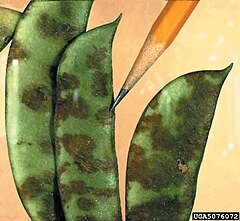Colletotrichum lindemuthianum
| Colletotrichum lindemuthianum | |
|---|---|
 |
|
| Colletotrichum lindemuthianum damage to bean pods. | |
| Scientific classification | |
| Kingdom: | Fungi |
| Phylum: | Ascomycota |
| Class: | Sordariomycetes |
| Subclass: | Incertae sedis |
| Order: | Phyllachorales |
| Family: | Phyllachoraceae |
| Genus: | Colletotrichum |
| Species: | C. lindemuthianum |
| Binomial name | |
|
Colletotrichum lindemuthianum (Sacc. & Magnus) Briosi & Cavara, (1889) |
|
| Synonyms | |
|
Gloeosporium lindemuthianum Sacc. & Magnus, (1878) |
|
Gloeosporium lindemuthianum Sacc. & Magnus, (1878)
Glomerella cingulata f.sp. phaseoli
Glomerella lindemuthiana Shear [as 'lindemuthianum'], (1913)
Colletotrichum lindemuthianum is a fungus which causes anthracnose, or black spot disease, of the common bean plant (Phaseolus vulgaris). It is considered a hemibiotrophic pathogen because it spends part of its infection cycle as a biotroph, living off of the host but not harming it, and the other part as a necrotroph, killing and obtaining nutrients from the host tissues.
The anthracnose of common bean was first identified in 1875 in the fruit and vegetable garden of the Agricultural Institute of Popplesdorf, Germany by Lindemuth. By 1878, Saccardo and Magnus had made many observations on the cause of the anthracnose disease, recording their results in Michelia I:129. They concluded that it was caused by a fungus, which they named Gloeosporium lindemuthianum after Lindemuth himself. Several years later, Briosi and Cavara discovered the presence of setae on the fungus, reclassifying it from the Gloeosporium genus to Colletotrichum, where it remains today. Recognizing the devastating effect the fungus was having on common bean populations worldwide, it quickly became a heavily studied subject among scientists, who principally investigated means of controlling its spread. In 1911, Barrus reported the discovery of multiple fungal strains, each of which differed in its ability to infect certain varieties of bean plants, which initiated the work of Edgerton and Moreland, who found eleven different strains of the pathogen, but theorized more may exist. Since then, numerous strains have been identified, each targeting specific varieties of bean plants. During the early part of the 20th century, the various races were identified by use of the Greek alphabet, paired with numbers, but at the turn of the 21st century a naming system using binary code was adopted. Under the binary naming system, each plant cultivar is given a binary number, and the code for a particular race of the pathogen is determined by the sum of the binary numbers of the cultivars which it infects
The spores of C. lindemuthianum are dispersed by rain splash and must quickly attach to the aerial parts of the plant in order to infect the host. A heavy rainfall may spread the spores as far as 4.5 meters from the host plant. The spore will then germinate on the new host and form a short germ tube which develops an appressorium, or 'pressing' organ. As the germ tube grows, it pulls the spore and the appressorium together, causing an indectation to occur in the cell wall. An infection peg is then able to protrude from the appressorium and penetrate through the cell wall. Once through the cell wall, an infection hypha grows and develops into an infection vesicle.
...
Wikipedia
